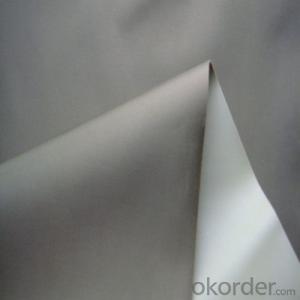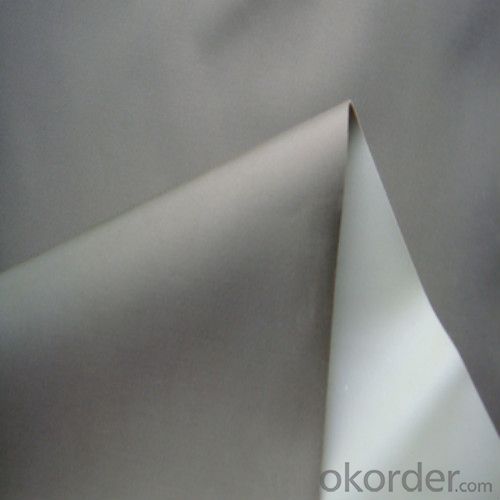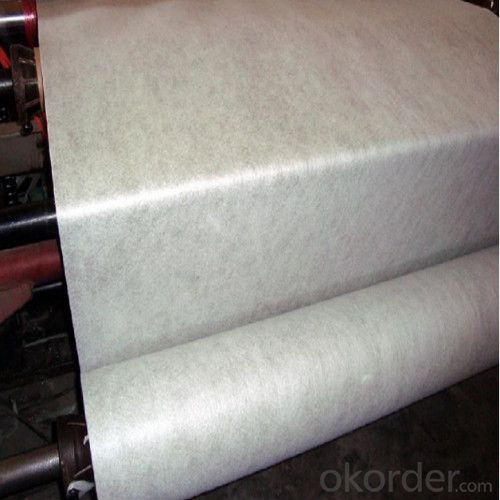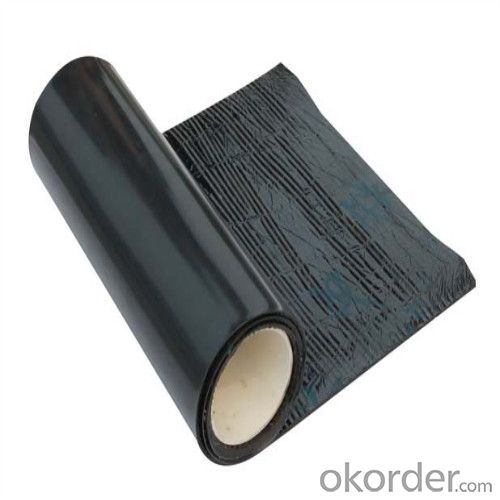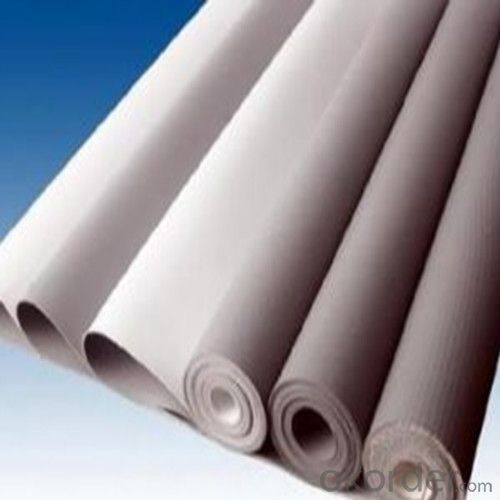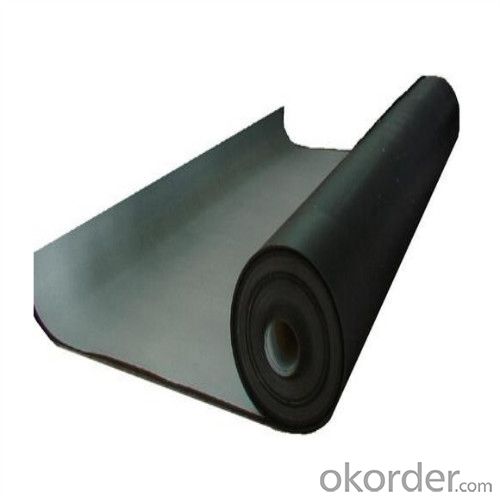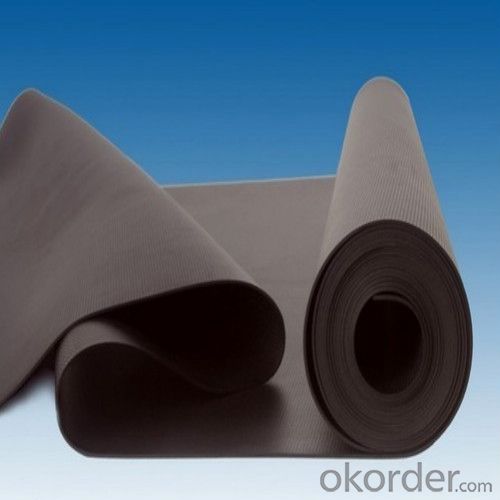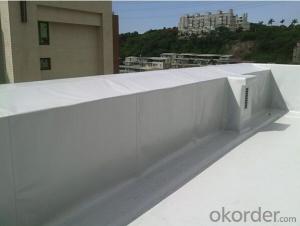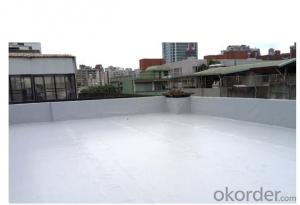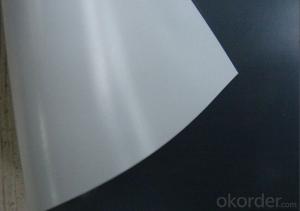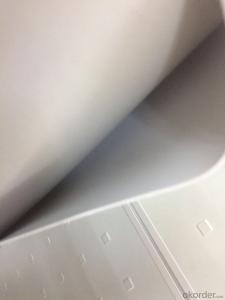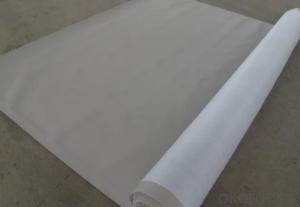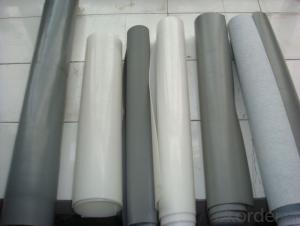Sheet Waterproof Membrane from Manufacture
- Loading Port:
- Tianjin
- Payment Terms:
- TT OR LC
- Min Order Qty:
- 1000 m²
- Supply Capability:
- 1000000 m²/month
OKorder Service Pledge
OKorder Financial Service
You Might Also Like
Sheet Waterproof Membrane from Manufacture
TPO Type and Specification
Type:
·PMT-3010 homogeneous thermoplastic polyolefin (TPO) waterproof sheet material.
·PMT-3020 Fiber backing thermoplastic polyolefin (TPO) waterproof sheet material.
·PMT-3030 reinforced thermoplastic polyolefin (TPO) waterproof sheet material.
Specification:
| Thickness of sheet material (mm) | Width of sheet material (m) | Length of sheet material (m) |
| 1.2 | 1.5,3.0 | 15,20,30 |
| 1.5 | 15,20,30 |
Advantages
·This product has perfect weather resistance,durability of EPR and the weldability of polypropylene;
·It has special technology for formula with no plasticizer which embrittles material it has high flexibility without embrittling phenomenon caused by migration of plasticizer in polyolefin , to have long time waterproof performance;
·There is an interlayer of polyester fiber fabric, offering high tensile strength, fatigue resistance, puncture resistance,which is adaptive to mechanically mounted roofing system
·Excellent low and high temperature flexibility: It is flexible even under -50℃ ,and still has mechanical strength at higher temperature;
·Chemical resistance: Resistant to erosion of acid, alkali, salt, plant oil, lubricating oil, resistant to microbial growth like algae and mould etc.
·Resistance of heat aging, good dimensional stability.
·White priority light color,smooth surface, high reflectance,better energy saving effect; Pollution resistance.
·NO chlorinated polymer or chlorine gas in ingredient,therefore no emission of chlorine during welding and other process, harmless to surroundings and humans.
·We use heatsealing to overlap, in order to form a high strength sealing layer.
Application Range
Used for all kinds of roof waterproof projects for various industrial building, civil building and public building etc.
Application Method of Construction
·PMT—3030 reinforced sheet material is adaptive to mechanically mounted waterproof system.
·PMT—3020 fiber backing sheet material is adaptive to fully bonding concrete base waterproof system.
·PMT—3010 homogeneous sheet material is adaptive to waterproof treatments for water flashing portion and for detail nodes.
CPE:
Description:
Chlorinated polyethylene waterproofing membrane are developed by our own factory, producing a new type of high-strength special waterproofing bridge, this product is based on chlorinated polyethylene-based materials, adding modifiers, anti-aging agent and promoting agents and some other enhancer complex formed by mixing two-sided rolling. With a big rally, high elasticity, oil resistance, flame resistance, weather resistance and long service life and other
comprehensive features. The product is cold construction waterproofing materials, construction, easy operation, and from climate conditions.
Application Range:
This product is suitable for all kinds of industrial and civil building roof, basement, reservoirs, ponds, sewage treatment system, civil air
defense projects, channel, girder factory waterproofing. Especially for highways, railways and culverts, bridges and other water impermeable
concrete bridge deck construction.
EPDM:
TYPE:
1. (TBD) self-adhesive rubber waterproofing membrane
Description:
EPDM (TBD) selfadhesive rubber waterproofing membrane is used (OP) rubber waterproofing membrane as based materials, Surface coating Nano-polymer adhesive glue squeeze a new high-strength self adhesive waterproofing.
Advantages:
1. High adhesive strength, durability, long after the bond;
2.Excellent weathering resistance, aging resistance;
3. Nano stabilizer added ingredients, low heat dimensional change;
4. High tensile strength, elongation, strong grass-roots stretching or cracking adaptability, resistance to low temperatures, can be adapted to -40 ℃;
5.Cold installation, easy to operate, reduce environmental pollution and improve working conditions of workers;
Application Range:
EPDM (TBD) selfadhesive waterproofing membrane used in roofing projects, exposed roofing, building foundations, basements, storage tanks, subways, tunnels, supermarkets, airports and other buildings waterproof.
2.(OP) EPDM R ubber Waterproofing membranes
Description:
EPDM (OP) Rubber Waterproofing membranes is a synthetic rubber, synthetic tire blends as the base material, adding reinforcing agents, softeners, antioxidants, curing agents processing aids to promote mixing by kneading, mixing, extrusion, rolling and curing, shaping and other processes can be processed into sheet curling volume of new high elastic waterproof material.
Application Range:
Mainly used in all types of Industrial and civil b uildings
roofing , office buildings, supermarkets, steel roofing, basements, tunnels, bridges
and other impermeable, waterproof construction .
FAQ:
1. Q: Can I get some samples?
A: We are honored to offer you samples for quality check.
2. Q: Do you have the products in stock?
A : Yes , We have sample for several models now could supply to you.
3. Q: What's the delivery time?
A: It usually takes about 25 days to produce an order. But the exact delivery time might be different for different orders or at different time.
4. Q: How does your factory do regarding quality control?
A: Quality is priority. Rock drilling tools workers always attach great importance to quality control from the every beginning to the end of the production.
Every product will be fully assembled and carefully tested before it's packed for shipment.
5. Q: Will you deliver the right goods as ordered? How can I trust you?
A: Yes, we will. Our company is world top 500, that is the biggest supplier and manufacture in China, having a good reputation around the world.
- Q: APP selection of asphalt waterproofing membrane selection points
- 2, Ⅱ type polyester tire modified PET asphalt waterproofing membrane, with a large pull, high elongation, heat resistance and good low temperature flexibility and so on. Applicable to the general and relatively cold or more hot areas, waterproof level for the I, Ⅱ, Ⅲ level roof waterproofing works.
- Q: Are waterproofing membranes resistant to fire?
- Yes, waterproofing membranes can be resistant to fire. Many waterproofing membranes are designed to have fire-resistant properties to ensure the safety of the structure. These membranes are typically made of materials that have high fire ratings and are able to resist the spread of flames. Fire-resistant waterproofing membranes are commonly used in areas where fire safety is a concern, such as commercial buildings, high-rise structures, and industrial facilities. Additionally, these membranes are often tested and certified by relevant authorities to ensure their fire resistance capabilities. However, it is important to note that not all waterproofing membranes are fire-resistant, so it is crucial to select the appropriate membrane based on the specific fire safety requirements of the project.
- Q: Can a waterproofing membrane be tiled over?
- Certainly, tiling over a waterproofing membrane is possible. Actually, it is strongly advised to incorporate a waterproofing membrane prior to tiling in areas susceptible to moisture, like bathrooms, showers, and outdoor patios. This membrane serves as a protective shield, preventing water from seeping through and safeguarding the underlying structure from harm. By placing tiles directly on the membrane, the durability and longevity of the tile installation are assured. It is crucial to adhere to the manufacturer's instructions and utilize suitable adhesives and grouts that harmonize with the waterproofing membrane to guarantee a triumphant and water-resistant tile installation.
- Q: Can a waterproofing membrane be used for a swimming pool deck?
- Yes, a waterproofing membrane can be used for a swimming pool deck. Waterproofing membranes are commonly used in construction and are designed to prevent water penetration. They are typically applied to surfaces such as concrete or wood to ensure that water does not seep through and cause damage. For a swimming pool deck, where exposure to water is constant, using a waterproofing membrane can help protect the underlying structure and prevent issues such as water damage, rotting, or mold growth. Additionally, a waterproofing membrane can also provide a slip-resistant surface, enhancing safety for pool users.
- Q: Can a waterproofing membrane be used in high-traffic areas?
- Yes, a waterproofing membrane can be used in high-traffic areas. These membranes are designed to provide a protective barrier against water and moisture, making them suitable for use in areas that experience heavy foot traffic. They are durable, resistant to wear and tear, and can help prevent water damage and leakage in such areas.
- Q: Pvc waterproof membrane of the scope of application
- PVC polymer waterproofing membrane Features: 1, PVC waterproofing membrane tensile strength, elongation is good, thermal size change rate is small; 2, anti-aging, resistant to ultraviolet radiation, chemical resistance, resistance to root penetration;
- Q: Are waterproofing membranes environmentally friendly?
- Waterproofing membranes can vary in their environmental impact depending on the materials used. Some waterproofing membranes, such as those made from recycled materials or natural substances, can be considered more environmentally friendly. However, other membranes made from synthetic materials or those containing harmful chemicals may have a negative impact on the environment. It is essential to consider the specific type of membrane and its composition to determine its overall environmental friendliness.
- Q: Are there any specific considerations for installing a waterproofing membrane in high-traffic areas?
- Yes, there are several specific considerations when installing a waterproofing membrane in high-traffic areas. Firstly, the durability and strength of the membrane should be a top priority. High-traffic areas are subject to constant wear and tear from foot traffic, heavy equipment, and other activities. Therefore, the membrane should be able to withstand the load and pressure without getting damaged or compromised. Secondly, the slip resistance of the waterproofing membrane is crucial in high-traffic areas to prevent accidents and ensure safety. The surface of the membrane should provide sufficient grip to minimize the risk of slips and falls, especially in wet conditions. Additionally, the installation process should be carefully planned and executed in high-traffic areas. It is essential to minimize disruptions and inconveniences to the people using the area. This may involve scheduling the installation during off-peak hours or implementing temporary alternative pathways to ensure smooth traffic flow. Furthermore, the choice of materials is important in high-traffic areas. The waterproofing membrane should be resistant to chemicals, oils, and other substances that may be commonly found in such areas. This will help to prolong the lifespan of the membrane and maintain its functionality over time. Lastly, regular maintenance and inspection are crucial for long-term performance in high-traffic areas. The membrane should be regularly checked for any signs of damage or deterioration, and necessary repairs or replacements should be promptly carried out to ensure the continued effectiveness of the waterproofing system. In conclusion, installing a waterproofing membrane in high-traffic areas requires careful consideration of durability, slip resistance, installation process, material choice, and maintenance. By addressing these specific considerations, a waterproofing membrane can effectively protect the underlying structure while accommodating the demands of heavy foot traffic.
- Q: Can a waterproofing membrane be used in residential construction?
- Yes, a waterproofing membrane can be used in residential construction. Waterproofing membranes are commonly used in various areas of a residential property, such as roofs, basements, bathrooms, and foundations. These membranes are designed to prevent water penetration and protect the structure from moisture-related damages. By installing a waterproofing membrane, homeowners can ensure that their property remains dry and free from water leaks, which can lead to mold growth, structural deterioration, and other costly issues. There are various types of waterproofing membranes available in the market, including sheet membranes, liquid membranes, and self-adhering membranes, each with its own advantages and suitability for specific applications. Consulting with a professional contractor or architect can help determine the most appropriate waterproofing membrane for a particular residential construction project.
- Q: Can waterproofing membranes be applied over existing surfaces?
- Yes, waterproofing membranes can be applied over existing surfaces. In fact, this is a common practice in construction and renovation projects. Waterproofing membranes are designed to provide a protective barrier against water infiltration, and they can be applied over various surfaces such as concrete, wood, metal, or even other waterproofing systems. By applying a waterproofing membrane over an existing surface, it helps to prevent water damage, including leaks, mold growth, and structural deterioration. However, it is important to ensure that the existing surface is properly prepared and cleaned before the membrane application to achieve optimal adhesion and performance. Additionally, it is recommended to consult with a professional waterproofing contractor to determine the most suitable membrane type and installation method for the specific project requirements.
Send your message to us
Sheet Waterproof Membrane from Manufacture
- Loading Port:
- Tianjin
- Payment Terms:
- TT OR LC
- Min Order Qty:
- 1000 m²
- Supply Capability:
- 1000000 m²/month
OKorder Service Pledge
OKorder Financial Service
Similar products
Hot products
Hot Searches
Related keywords
